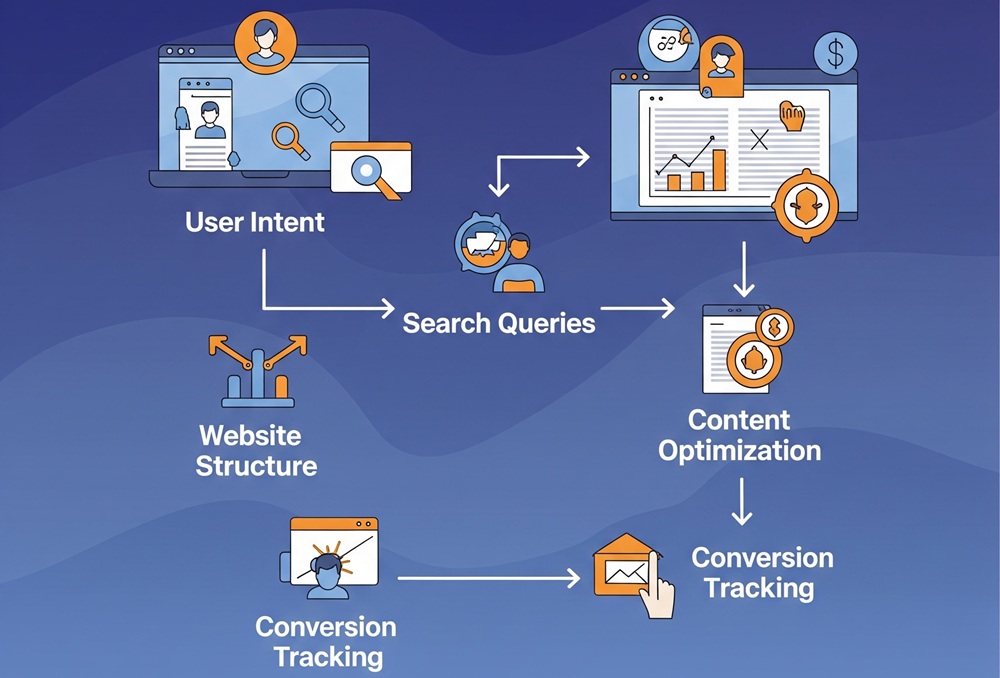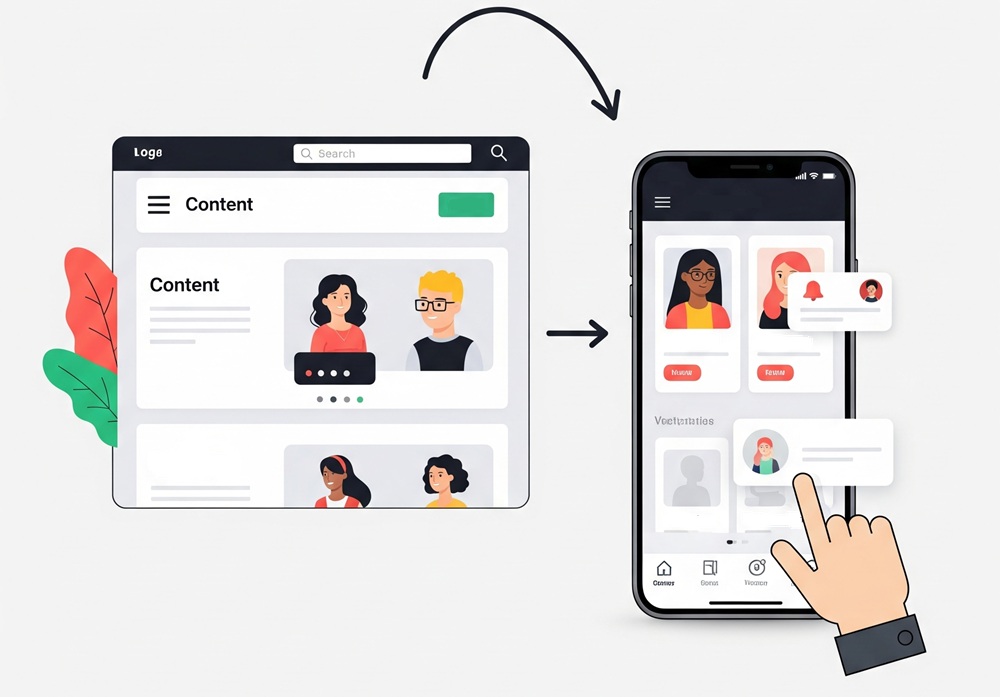Visual discovery can also drive people’s buying decisions. That makes Pinterest a powerful search engine with 400+ million monthly active users. Yet, Pinterest remains an untapped goldmine for traffic, visibility, and conversions.
That’s where Pinterest SEO helps users get ideas, inspiration, and products. A smart strategy skyrockets your reach and drives high-intent traffic to your site. Dive into the acts that make Pinterest work like a search engine, not a social feed.
Table of Contents
Toggle- What is Pinterest SEO?
- Top Pinterest SEO Strategy for Your Success
- Strategy #01: Set Up and Optimize Your Pinterest Business Profile
- Strategy #02: Keyword Research
- Strategy #03: Optimize Boards for Search Visibility
- Strategy #04: Design SEO-Friendly Pins
- Strategy #05: Publish and Schedule Consistently
- Strategy #06: Leverage Rich Pins and Pinterest SEO Features
- Strategy #07: Build Engagement and Authority
- Advanced Pinterest SEO Tips
- Frequently Asked Questions
What is Pinterest SEO?
It’s the strategic process of optimizing your Pins, boards, and profile to rank higher in Pinterest’s search results and related feeds. Traditional SEO focuses on Google, whereas Pinterest SEO is a visual-first and intent-driven platform.
How Pinterest’s Algorithm Works?
i. Relevance
Pinterest scans your Pin titles, descriptions, board names, and even image names to match with user search intent. Use long-tail keywords like “minimalist home office ideas” instead of just “home office”.
ii. Engagement
Pins with higher CTR, saves, and close-ups are prioritized. Pins with compelling visuals and keyword-rich details see up to 80% more engagement. Use text overlays on images to boost clarity and clickability.
iii. Freshness
Pinterest rewards new content, not only repins. Fresh Pins (even with the same URL) are treated as new with changes. Create multiple Pins for the same blog post or product using different visuals and titles.
iv. Authority
Accounts that consistently post high-quality, relevant content and engage with their audience rank higher. Pin regularly (at least 3–5 times a week) and maintain niche consistency.
Pinterest as a Visual Search Engine
- Image Recognition: Pinterest uses AI to analyze visuals, colors, objects, and layout to categorize Pins.
- Text Overlays: Words on images are scanned and indexed. Use clear, readable fonts and relevant phrases.
- Metadata Matters: Pinterest reads image file names, alt text, and EXIF data. Rename files like `IMG_1234.jpg`.
Top Pinterest SEO Strategy for Your Success
Strategy #01: Set Up and Optimize Your Pinterest Business Profile
Switch to a Business Account
- Pinterest Analytics: Gain access to detailed metrics on impressions, saves, clicks, and audience demographics.
- Ads Manager: Run targeted campaigns using interest, keyword, and audience-based targeting.
- Rich Pins: Automatically sync metadata from your website (e.g., product price, availability, recipe ingredients).
- Keyword Insights: Discover trending search terms and optimize content accordingly.
Optimize Profile Elements
- Profile Name: Include your primary keyword to improve discoverability. Use keywords that reflect your niche and audience search behavior.
- Username: Keep it consistent with your brand name across platforms. For example, a brand, “EcoNest Living”, should use `@econestliving`.
- Bio: Write a keyword-rich description that communicates your niche, expertise, and value. Brands in India and Brazil use bilingual bios (English + Hindi/Portuguese).
- Profile Picture: Use a professional logo or headshot to build trust and brand recognition. Ensure it’s high-resolution and matches your branding.
Claim Your Website
Claiming your website connects your domain to your Pinterest account.
- Verification: Confirms ownership and boosts credibility.
- Analytics Tracking: Enables performance insights for Pins linked to your site.
- Brand Attribution: Adds your profile picture and link to Pins saved from your site.
Add a Pinterest Tag
The Pinterest Tag is a piece of code added to your website to track user actions.
- Conversion Tracking: See which Pins lead to sign-ups, purchases, or downloads.
- Audience Insights: Build retargeting audiences based on site behavior.
- Campaign Optimization: Improve ad performance by analyzing funnel metrics.
Strategy #02: Keyword Research
Pinterest-Specific Keyword Research Methods
- Pinterest Search Bar Autocomplete: Start typing a keyword (Pinterest SEO) and observe the auto-suggestions that appear. These are real-time, high-volume search terms.
- “People Also Search For” Section: After searching a term, scroll down to see related keyword bubbles. These offer semantic variations and adjacent topics.
- Competitor Boards and Pins: Analyze top-performing Pins in your niche. Look at Pin titles, descriptions, and board names. Identify recurring keywords and phrases that rank well.
- Pinterest Trends Tool: Use Pinterest Trends to explore seasonal search volume and rising keywords. Also, apply a filter by country and category.
Keyword Placement Opportunities
- Pin Titles: Use primary keywords up front (“Pinterest SEO Strategy for Beginners”).
- Pin Descriptions: Include related keywords naturally in 1 – 2 sentences.
- Board Names: Be specific (“Pinterest Marketing Tips” vs. “My Pins”).
- Board Descriptions: Add 2–3 keyword-rich sentences.
- Image File Names: Rename files before uploading (`pinterest-seo-strategy-2025.jpg`).
- Profile Bio: Incorporate niche-defining keywords to improve discoverability.
Strategy #03: Optimize Boards for Search Visibility
Create Niche-Specific Boards
Pinterest rewards specificity over generality. Each board should revolve around a single, well-defined keyword topic.
Pinterest’s algorithm uses board context to determine what your Pins are about. A niche board reinforces keyword relevance.
Example: Instead of a broad board like “Marketing”, create “Pinterest Marketing for Bloggers” or “Pinterest SEO Tips 2025.”
Optimize Board Details
- Board Title: Use clear, keyword-rich titles that match what users are searching for. Boards with keyword-optimized titles rank 3× more often in search results.
- Board Description: Write 2 – 3 natural sentences using your primary and secondary keywords. Avoid keyword stuffing; Pinterest favors semantic relevance over repetition.
- Board Cover: Design a visually cohesive cover using your brand colors, fonts, and style. Builds brand recognition and makes your profile look polished.
Organize Boards Strategically
- Top-Performing Boards: Pin your most active or seasonal boards to the top of your profile. Example: In November, move “Holiday Gift Guides” or “Winter Wellness Tips” to the top.
- Private Boards: Hide boards that are off-brand, outdated, or experimental. It keeps your profile focused and relevant. Pinterest’s algorithm reads your board order. Prioritize what you want to rank for.
Strategy #04: Design SEO-Friendly Pins
Pinterest Image Optimization
- Size: The ideal Pin ratio is 2:3, typically 1000 x 1500 pixels. Pins outside this ratio may be cropped or deprioritized in feeds.
- Quality: Use clear, bright, vertical images with high resolution. Avoid cluttered visuals or dark, low-contrast designs.
- Branding: Include your logo, consistent color palette, and fonts to build recognition. Maintain visual consistency across all Pins to reinforce brand identity.
Text Overlay Optimization
Add primary keywords directly onto the image. Use readable fonts, balanced spacing, and high contrast for clarity. Avoid placing text too close to edges; Pinterest may crop it in previews.
Pin Title Optimization
Use up to 100 characters, placing the main keyword at the beginning. Make it compelling and specific. Example: “10 Pinterest SEO Tips to Boost Website Traffic in 2025”
Pin Description Optimization
Descriptions provide context and help Pinterest understand your content. Write 2 – 3 natural sentences using 3–5 related keywords. Include a clear CTA like “Click to read more” or “Save for later”.
Use Alt Text
Alt text improves accessibility and adds another layer of SEO relevance. Describe the image clearly and concisely. Include primary keywords naturally.
Strategy #05: Publish and Schedule Consistently
Frequency of Pinning
Pinterest rewards consistent activity, not sporadic bursts. Pin 5 – 15 times per day, mixing fresh and repinned content. Spread Pins throughout the day to maintain visibility across time zones and user sessions.
Use Pinterest Scheduling Tools
Manual posting is no longer sustainable for growth. Use tools to automate and optimize.
- Tailwind: Offers smart scheduling, analytics, and Pin creation.
- Later: Great for visual planning and multi-platform scheduling.
- Buffer: Ideal for teams managing multiple accounts.
Fresh Content Strategy
Pinterest’s algorithm prioritizes fresh Pins, even if they link to the same URL. Fresh means a new image, title, or description. Repinning old content without changes has diminishing returns.
Pin Mix Strategy
Balance is key to building trust and relevance. For instance,
- 80% Original Pins: Your own blog posts, products, infographics, guides.
- 20% Curated Content: Repin high-quality, niche-relevant content from others.
Strategy #06: Leverage Rich Pins and Pinterest SEO Features
Rich Pins are enhanced Pins that pull structured data directly from your website. It allows Pinterest to display extra details, making your Pins more informative and actionable.
How it works: Once your site is validated, Pinterest syncs metadata with your Pins.
Why it matters: Rich Pins stand out in feeds, offer more context, and improve search relevance.
Types of Rich Pins
- Article Pins: Ideal for bloggers, educators, and publishers. Display the title, author, and meta description of your blog post or article. Help users quickly understand the content and its source.
- Product Pins: Perfect for eCommerce brands and online retailers. Include real-time price, availability, and product description. Automatically update when product details change on your site.
- Recipe Pins: Designed for food bloggers and culinary brands. Show ingredients, cooking time, and serving size. Make Pins more useful for users planning meals or events.
How to Enable Rich Pins?
- Add metadata to your site using Open Graph or Schema.org.
- Validate your URL using Pinterest’s Rich Pin Validator.
- Apply once; Pinterest will automatically apply Rich Pin formatting.
Strategy #07: Build Engagement and Authority
Encourage Saves and Clicks
Create visually shareable content: Infographics, checklists, and how-to guides perform exceptionally well. These formats are easy to digest and often saved for future reference.
Add a CTA in your image text: Phrases like “Pin it for later,” “Save this guide,” or “Click to learn more” prompt action.
Engage with the Pinterest Community
Pinterest isn’t a sole publishing platform; it’s a community of creators and curators. Follow relevant accounts in your niche to stay updated and build reciprocal visibility.
Re-pin quality content that complements your brand. It shows Pinterest you’re active and niche-aware. Comment thoughtfully on others’ Pins to spark conversation and build relationships.
Collaborate Using Group Boards
Group boards allow multiple contributors to post content around a shared theme, expanding reach and authority. Join niche-specific group boards that align with your content.
Post consistently to stay visible in collaborative feeds and benefit from shared audiences. Contributors to active group boards receive up to 35% more repins than solo board users.
Leverage Idea Pins (formerly Story Pins)
Idea Pins are multi-page, interactive Pins designed for tutorials, storytelling, and engagement. Great for step-by-step guides, product demos, or behind-the-scenes content.
Keep users engaged directly on Pinterest, increasing dwell time and algorithmic favor. Idea Pins generate up to 9× more saves and are favored in mobile feeds.
Advanced Pinterest SEO Tips
Optimize for Google Search
Pinterest content doesn’t just live on Pinterest, as it ranks on Google, too. Pinterest boards and Pins often appear in Google’s image and web results, especially for visual or lifestyle-related queries.
Use consistent keywords across your Pinterest profile, board titles, Pin descriptions, and your website content. Optimized Pinterest boards can rank on Google’s first page for long-tail keywords.
Seasonal and Trending Optimization
Pinterest is a planning platform; users search for seasonal content weeks in advance. Plan content 45 – 60 days ahead of key events like holidays, school terms, or cultural festivals.
Use the Pinterest Trends Tool to identify rising seasonal keywords. In the US, searches for “Christmas decor ideas” begin as early as October, while in Australia, “summer BBQ recipes” trend in November.
Cross-Promotion
Pinterest SEO thrives when integrated with your broader content strategy. Embed Pinterest boards or Pins on your website using Pinterest’s widget builder.
It should keep your site dynamic and encourage saves. Promote Pins via email newsletters, blog posts, and platforms like Instagram, LinkedIn, or Facebook.
Use Pinterest Ads Strategically
Pinterest Ads can amplify your organic reach and accelerate growth. Promote high-performing Pins to extend their visibility and test new audiences.
Use keyword and interest targeting to reach users actively searching for your niche. Start with a $5–10/day budget promoting Pins that already perform well.
The time to use Pinterest for inspiration is over. It’s a strategic search engine for visibility, traffic, and growth. Master Pinterest SEO and you’re set to optimize Pins for building a long-term ecosystem.
Contact Tectera who offers SEO services in Toronto for more details.
Frequently Asked Questions
Use Pinterest’s search bar autocomplete, the “People also search for” bubbles, and the Pinterest Trends tool. Analyze competitor Pins and boards for inspiration. Focus on long-tail keywords as well.
Strategically place keywords in –
Pin titles and descriptions.
Board names and descriptions.
Profile bio and display name.
Image file names and alt text.
Aim to post 5 – 15 Pins per day, spaced throughout the day. Consistency is key; implement scheduling tools like Tailwind or Later to automate posting and maintain a steady presence.
Create niche-specific boards with keyword-rich titles and descriptions. Use branded board covers for visual consistency. Organize your boards by relevance and seasonality, and keep outdated or off-topic boards private.
Rich Pins pull metadata from your website to enhance your Pins with real-time information. They can improve credibility, increase click-through rates, and keep your Pins updated automatically.
Get Pinterest Analytics to monitor impressions, saves, and clicks. Use Google Analytics to track referral traffic, bounce rates, and conversions. Optimize based on top-performing Pins and update the others.











